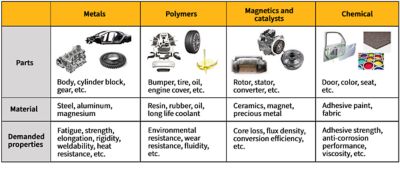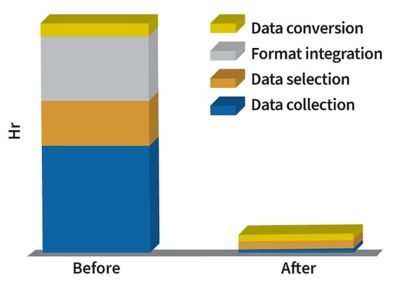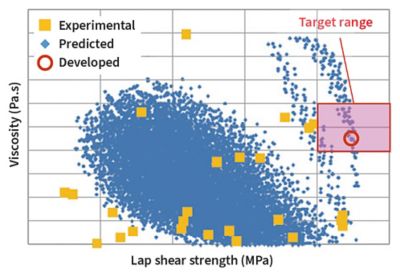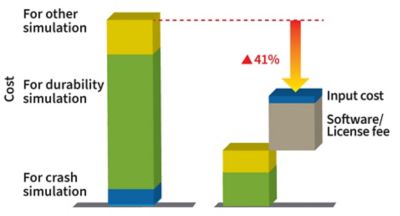-
-
学生向け無料ソフトウェアにアクセス
Ansysは次世代の技術者を支援します
学生は、世界クラスのシミュレーションソフトウェアに無料でアクセスできます。
-
今すぐAnsysに接続!
未来をデザインする
Ansysに接続して、シミュレーションが次のブレークスルーにどのように貢献できるかを確認してください。
国および地域
無料トライアル
製品およびサービス
リソースとトレーニング
当社について
Back
製品およびサービス
ANSYS ADVANTAGE MAGAZINE
July 2021
Honda Motor Improves Development Efficiency with a Materials Database
By Ansys Advantage Staff
The transformation of the automotive industry toward lighter vehicles, hybrid and electric powertrains, more advanced driver assistance systems (ADAS), and more luxurious interiors touches every part of the global engineering workflow, including:
- New manufacturing methods
- Development of high-efficiency, lightweight engines and motors
- Reduction in vehicle body weight
- Noise reduction
One element of design spans every engineering discipline involved in automotive development: materials. Automobile manufacturers are researching and developing new materials to differentiate their brands and are working with suppliers to ensure that the best, most sustainable material choices are being made, creating an enormous amount of materials data to track and manage.
Materials classification and required properties
Tsuyoshi Ito, who works in Honda Motor’s Automobile Operations, was so convinced of the importance of materials that he began building a materials information management system himself. Ito is assistant chief engineer in the Power Unit Materials Section of the Materials Development Division, Automobile Development Supervisory Unit, in the company’s Monozukuri Center. Ito then recommended that the company license Ansys Granta MI, materials information management software, to centrally manage materials information owned by each individual, and use materials informatics, which integrates collected information with a statistical method, to create new value in the materials field.
Importance of a Cross-Divisional Materials Information Management System
Ito has developed aluminum structural parts for engines since joining Honda R&D, the research and development division of the Honda Group, to address development issues from a materials point of view. In his work, he uses computer-aided engineering (CAE) to develop methods to predict heat-treatment residual stress, evaluate high-cycle fatigue strength and test various materials.
With the introduction of Granta MI, Honda Motor has built a full-featured materials information management system, making their materials information much more sophisticated. The need for lightweighting has driven the adoption of lighter materials for engines and bodies, such as resin and magnesium, and additive manufacturing technology has been studied to develop the new materials with unconventional properties. In model-based development, which is common in the automotive industry, simulation (CAE) is used for one-dimensional analysis and crash analysis, which require more advanced material models.
Change in data cleansing time after implementing Ansys Granta MI
Changes in the social environment also place greater importance on materials management. In an age when people with different values and nationalities work together, the way companies share their information and know-how directly translates into profit. In materials development, attention is also focused on data-oriented research, which uses not only an experiment, a theory and a simulation, but also a statistical treatment.
For these reasons, there was a rise in demand for information sharing or integration with development systems across categories. At the time Ito built his own database, however, the company had no comprehensive materials information management system. Materials data was collected in an unorganized way by each department or individual.
“First, manage scattered materials data centrally to increase the efficiency of data sharing,” says Ito, explaining the steps toward mining value from materials data. “Then, use it for data science or data engineering and ultimately develop materials using materials informatics so that we can create new value.”
Ansys Granta MI Solves Materials Database Creation Challenges
The range of materials used in automobile development is wide, so Ito categorized the current data issues when building a materials information management system into the following large materials groups: metal, organic, functional and chemical. All groups contain various materials, each of which has a different manufacturing process and different demand characteristics and must be handled with special skills. Therefore, a person needs to be assigned to each specific material, leading to the unorganized management of materials data. Necessary materials data also varies from person to person, depending on roles such as design, CAE and materials.
Property-predicted results of adhesive materials
Ito listed the following four possible problems in materials information management system management and operation:
- Input template items must be frequentlychanged to support materials data andmanufacturing technologies that areupdated on a daily basis.
- Data expression inconsistency dueto input by multiple people must becorrected.
- A hierarchy required to organize a large amount of materials data must beadded or modified.
- Data must be output so that it can befreely utilized.
Ito’s group chose the Granta MI Enterprise solution to solve these problems. The materials information management system automatically updates added or modified input items to the input template, eliminating the need to create items again. All specific item data can be output and used, and also modified and put back into the system, which makes it easy to edit a large amount of data or change a hierarchy.
“I compared Ansys Granta MI to other similar database software in terms of input, display, search, output, management and cost,” Ito says. “Because of its huge comparative advantage, including extra functions to automatically create a link between records and overlap graphs contained in multiple records, we chose Granta MI.”
Materials Analytics Reduces Development Time
Since introducing Granta MI, Ito has promoted the materials information management system throughout the company. First, he divided the system structure into areas where users with different roles, such as designers and design experts, can store their specific data. Then, he added access control to the areas and linked them to each other so that data can be handled by all users. For easier access rights management, an intermediate team was created, which enables an administrator to manage user access rights to the database for each team. By using Granta MI to make material models available for simulation purposes, it increases CAE work efficiency and reduces materials testing, typically duplicated by different departments. Material property acquisition costs were reduced by an estimated 40% for simulation models.
There are also user-friendly features available to prevent misunderstandings or expression inconsistency among people who input data, such as showing the description of each term in a template and adding a function to select data from a list. This improves data quantity and quality, while streamlining data input.
The organized materials information management system allows the company to discover cases that could lead to new value creation using materials informatics. Materials informatics is an efficient materials development method that integrates materials data with machine learning, unlike conventional trial-and-error materials development. The most important thing in materials informatics is data quantity and quality. However, data collection, conversion and organization (data cleansing) generally require many man-hours, which is a serious problem in machine learning.
Honda Motor reviewed the effect of using materials informatics for designing a formulation in materials development. In general, materials properties change depending on infinite formulations, so many prototypes must be created and tested to achieve the target properties. Therefore, the company output the formulation information, test results and property information of materials stored in the materials information management system and input them for machine learning. The machine learning algorithm mechanically calculates properties in an unknown formulation, narrowing down formulation candidates to obtain the target properties.
Materials properties measurement costs were reduced by about 40% via Ansys Granta MI.
The results showed that the prediction was highly accurate because there were only small errors between the predicted and actual values of the properties of the selected materials. Compared to conventional trial-and-error development, the machine learning approach is proven to reduce the number of prototype materials and tests by about half.
Based on these results, Honda Motor decided to promote materials development using materials informatics by securing a large amount of materials data collected by materials experts, enhancing the materials information management system and increasing the number of database users. The company also plans to actively publish data to designers and analysts, and to integrate the database with a development environment, such as product lifecycle management (PLM), so that it can be used as a development platform.
“To operate a materials information management system in a company, it is important to first select a materials database tool suited for the usage purpose, tool coverage and corporate culture,” says Ito. “It is also necessary to design a database structure and give access control with consideration for user specialties and roles and conduct various promotional activities. Regarding utilization for materials development, storing data systematically to a materials information management system greatly reduces data cleansing, which results in more opportunities to use materials informatics.”
Reference
Honda R&D Technical Review, Vol. 32 No. 2, “Materials Database for Eff icient Development Using Materials Informatics,” Tsuyoshi Ito, Tatsuko Ishii, Akira Honda, Nao Sugimoto, Yoichi Toyooka, Itsuru Furusawa
さあ、始めましょう
エンジニアリング課題に直面している場合は、当社のチームが支援します。豊富な経験と革新へのコミットメントを持つ当社に、ぜひご連絡ください。協力して、エンジニアリングの障害を成長と成功の機会に変えましょう。ぜひ今すぐお問い合わせください。



